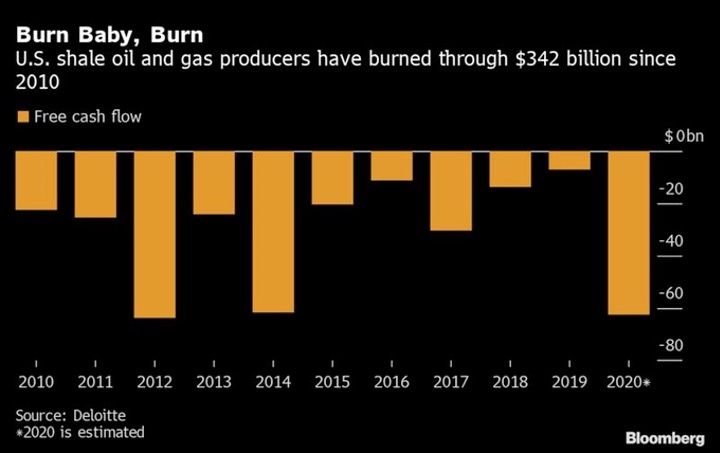The United States remained the world’s leading oil producer and exporter for much of the twentieth century…
— from ‘The Long Emergency: Surviving the Converging Catastrophes of the Twenty-First Century’, by James Kunstler, 2005.
Archuleta County witnessed a surprisingly prosperous summer — despite, or possibly because of, the global COVID crisis. Apparently, thousands of people who were expecting to use air travel for their vacation this year decided to drive to Pagosa Springs instead. Presumably, they wanted to keep using their automobiles while they are visiting. They may have noticed a thing or two about our local roads.
When we listened to Archuleta County Finance Director Larry Walton’s proposed budget presentation last October — and learned that the Commissioners were going to allocate Zero Property Tax Dollars ($0.00) to the Road & Bridge Department in 2021 — the report did not allow us to look into the future. Other similar County finance reports have indeed looked at where the County is headed financially, but those reports did not envision, for example, the complete “consumption” of the Strategic Fund Reserve to pay for a new courthouse building. I don’t recall if any of the previous reports had predicted a $2.5 million annual cost for the County’s newly-opened jail facility.
Maybe it’s better that we don’t look too far into the County’s future. Could be depressing. And Lord knows we have plenty of other depressing news right now.
Which doesn’t exactly explain why I would find myself on the midst of reading a depressing book… titled, The Long Emergency: Surviving the Converging Catastrophes of the Twenty-First Century, by James Howard Kunstler. He wrote the book in 2005 — over 300 pages of predictions of environmental, social, and economic catastrophes that the author believed the world would be experiencing soon… in fact, right about now… in the third decade of the 21st cenutry.
Although the book is focused on “converging catastrophes”, we note that the author also included the word “surviving” in his title. That should give us hope.
Meanwhile, many of his unpleasant premonitions center on America’s love affair with gasoline and diesel fuels, and in Mr. Kunstler’s view, the supply of those fuels is destined to run out, for a number of reasons — with no suitable replacement in sight. The book is, in fact, largely an analysis of all the changes he believes will inevitably be brought about by the event known as “Peak Oil” — the point in time when half the recoverable oil on the planet has been used up, and we are on a declining path in terms of supply.
As with most people who try to foretell the future in a reasonably rational manner, Mr. Kunstler made some authoritative predictions, back in 2005, that have not taken place in the exact way, and in the exact time frame, he predicted. He writes, on page 39, for example:
Europe and Asia were ravaged by [World War II], but the American mainland was not touched. The United States emerged with its manufacturing and oil infrastructure intact. Though discovery of oil — that is, the finding of new fields — had fallen off by then, the rate of production from fields already found would continue to rise until 1970. Where geology is concerned, North America may be the most minutely explored continent on earth. There are virtually no unknown oil fields of any significance left to be found here. No amount or kind of new technology will alter that.
One thing Mr. Kunstler didn’t foresee, however, was how the development of shale oil, and hydraulic fracturing — ‘fracking’ — would effect the oil and gas industry in the US. Beginning around the time Mr. Kunstler published his book, American oil companies began combining the technologies of horizontal drilling and hybrid fracking fluids… and completely changed America’s access to new domestic oil and gas from shale deposits… leading some political leaders to claim that the US had once again become “energy independent”… implying that we will no longer need to import oil from other countries.
Maybe that’s true. Or maybe not.
From the EIA (US Energy Information Administration) website:
The U.S. Energy Information Administration (EIA) cannot determine how much of the crude oil produced in the United States is then consumed in the United States. Most of the crude oil produced in the United States is refined in U.S. refineries along with imported crude oil to make petroleum products. EIA is not able to determine exactly how much of the crude oil exported from the United States is produced in the United States because some of the exported crude oil may originally have been imported from other countries, placed in storage, and then exported…
Faced with conflicting national and international data, we don’t know who to believe. Has fracking actually saved America from a lifetime of dependence on Saudi Arabia, Venezuela, and other OPEC countries? Or was the fracking revolution just an illusion?
Here’s a little graph published by Bloomberg.com, illustrating the fact that, since 2010, the US fracking industry has gone billions of dollars into debt. The technology behind fracking is remarkable, but the cost of extracting shale oil has been higher than what it sells for on the market. As the graph suggests, shale oil development was built upon borrowed money, and has yet to show a profit. Instead, we’ve seen eleven years of ever-increasing multi-billion dollar debt.
2020 was one of the worst years yet — a loss of $60 billion in one year.
Global “Peak Oil” — the moment when oil production begins an inexorable decline based on the lack of new discoveries, may have happened already, or it may happen in the near future… and perhaps Mr. Kunstler’s dire predictions will begin to come true. But something slightly different happened in 2020, that seems to have substantially changed the global energy conversation.
The dozens of recent news articles I’ve been reviewing for this editorial have been using a slightly different term: “Peak Demand”.
“Peak Demand” is not the same as “Peak Oil.” Partly as a result of the global pandemic and its effect on human transportation — workers working remotely, the decline in airplane travel, entertainment going online, the global demand for oil dropped from about 101 million barrels per day in 2019, to about 92 million barrels per day in 2020.
And partly because of the development of alternative energy sources… and partly because the automobile-centric suburban lifestyle has become less attractive…
The world has cut back on oil purchases for transportation. And we’re not sure… if the demand will ever come back…


